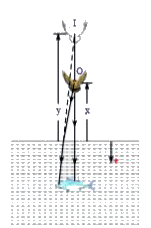Complete Solutions to Example of chapter REFRACTION OF LIGHT AT CURVED SURFACES of Class 10 book with complete answers and questions
| Class 10 | PHYSICS |
| Chapter | REFRACTION OF LIGHT AT CURVED SURFACES |
| TELANGANA | Example |
| Number Of Questions | 14 |
| Academic Year | 2023-24 |
A bird is flying down vertically towards the surface of water in a pond with constant speed. There is a fish inside the water. If that fish is exactly vertically below the bird, then the bird will appear to the fish to be :
Which of the four options are true? How can you prove it?View SolutionA transparent sphere of radius R and refractive index n is kept in air. At what distance from the surface of the sphere should a point object be placed on the principal axis so as to form a real image at the same distance from the second surface of the sphere?
 View Solution
View SolutionA transparent (glass) sphere has a small, opaque dot at its centre. Does the apparent position of the dot appear to be the same as its actual position when observed from outside?
View SolutionDraw a ray diagram to locate the position of image when a point source (S) is placed on optical axis MN of a convex lens, in such a way that it is beyond focal point `(F_(2))`.
View SolutionComplete the ray diagram to show the paths of the rays after refraction through the lenses shown in the figures?
 View Solution
View SolutionAn electric lamp and a screen are placed on the table, in a line at a distance of 1m. In what positions of convex lens of focal length of f = 21 cm will the image of lamp be sharp?
View SolutionWhat is the focal length of double concave lens kept in air with two spherical surfaces of radii `R_(1) = 30cm` and `R_(2) = 60cm`. Take refractive index of lens as n = 1.5.
View SolutionA bird is flying down vertically towards the surface of water in a pond with constant speed. There is a fish inside the water. If that fish is exactly vertically below the bird, then the bird will appear to the fish to be:
a. farther away than its actual distance.
b. closer than its actual distance.
c. moving faster than its actual speed.
d. moving slower than its actual speed.
Which of the four options are true? How can you prove it?
 View Solution
View SolutionA transparent sphere of radius R and refractive index n is kept in air. At what distance from the surface of the sphere should a point object be placed on the principal axis so as to form a real image at the same distance from the second surface of the sphere?
 View Solution
View SolutionA transparent (glass) sphere has a small, opaque dot at its centre. Does the apparent position of the dot appear to be the same as its actual position when observed from outside?
View SolutionDraw a ray diagram to locate the position of image when a point source (S) is placed on optical axis MN of a convex lens, in such a way that it is beyond focal point (F). See figure E(4).
View SolutionComplete the ray diagram to show the paths of the rays after refraction through the lenses shown in the figures E5(a) and E5(b)?
 View Solution
View SolutionAn electric lamp and a screen are placed on the table, in a line at a distance of 1m. In what positions of convex lens of focal length of f = 21 cm will the image of lamp be sharp?
View SolutionWhat is the focal length of double concave lens kept in air with two spherical surfaces of radii `R_1 = 30cm and R_2 =60`cm. Take refractive index of lens as n = 1.5.
View Solution
Example questions and complete solutions for chapter REFRACTION OF LIGHT AT CURVED SURFACES of NCERT PHYSICS(TELUGU) of Class 10
